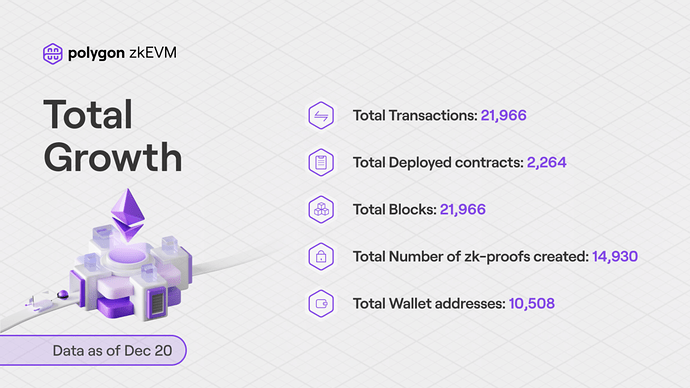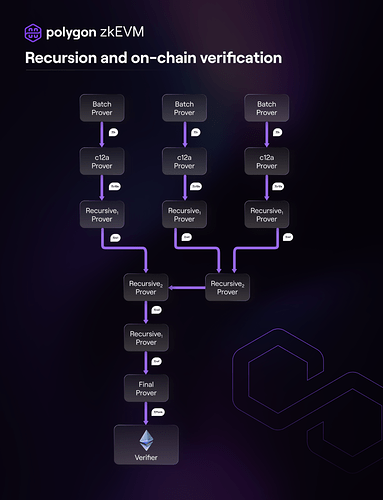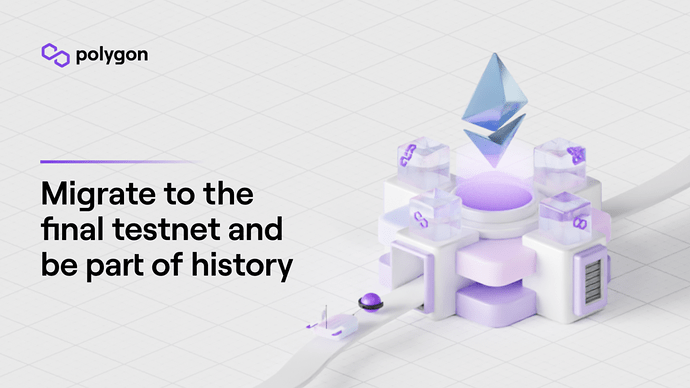We are so excited about the launch of our final testnet and the ongoing technical Audit of our zkEVM, these important steps are taking us closer to our goal: mainnet Q1 2023
Sharing our blog here with detailed information, we also like to take the opportunity to encourage you to ask questions here and open new topics of conversations you consider important for us to engage on anything you want to know about zkEVM tech.
Thanks to the zkEVM team who has worked non-stop to ship the final testnet!
Dec 21, 2022
When the first Polygon zkEVM public testnet launched in October, the distant future of Ethereum scaling became a reality, today.
Researchers at Polygon called for the community to join the testnet in the collaborative, built-in-public ethos that has defined Ethereum from the start. Developers can pour over the source code-available zero knowledge (ZK) proving system that drives Polygon zkEVM, and probe it for liveness right now, rather than some indistinct tomorrow.
To ensure the security of this bleeding edge breakthrough, Polygon recently announced an ongoing audit of Polygon zkEVM. Two security firms are tasked with analyzing 37 components of the zkEVM. The audit’s timeline? However long it takes. Security is not a race, and unearthing and stomping out bugs is an important step toward mainnet.
With the audit underway, Polygon is pleased to announce another milestone.
The final testnet before mainnet for Polygon zkEVM includes major upgrades to the code. Researchers at Polygon are introducing the pioneering use of recursion in a zkEVM, resulting in batch aggregation. In addition, an optimized prover now generates proofs for a batch in under 4 minutes (down from 10). With other optimizations in the pipeline**,** the final testnet shows how Polygon zkEVM will flex its muscles and deliver faster throughput at a low cost for users of Ethereum.
Tomorrow’s ZK scaling is happening on Polygon today.
(Almost) Final Form: Upgrading the Polygon zkEVM
First, a quick look at the total growth metrics from the first testnet:
Most expected features of Polygon zkEVM for mainnet are now implemented in the final testnet.
Minus whatever bugs the audit uncovers, you’ll have the chance to experience what Polygon zkEVM can do with complete EVM equivalence. So, what has been upgraded for the second testnet, and why is it important?
Recursion becomes reality
With the introduction of recursion, Polygon zkEVM can use one ZK validity proof to validate a batch of other ZK proofs, each of which can in turn validate multiple transactions. Think of it as exponential scaling.
The reason zkEVMs are considered a “Holy Grail” of scaling is simple: the ability to process many batches of transactions by rolling them up into a single proof. In the first testnet, Polygon zkEVM still operated with one batch of transactions to one proof.
But using recursion, any given ZK proof can in turn be aggregated and validated by a single, higher-level proof. It’s a bit like an infinite regress of two mirrors facing one another, with profound implications for scaling Ethereum.
Faster proof time, lower fees
The system supports multiple provers in parallel, allowing for scalability. Now proofs are generated faster, at a lower cost for users–which is already less than $.04 per transaction. Still, this will remain an area to work on in the coming months, as more research and upgrades are implemented to bring fees down even more.
Batch aggregation
Inside Polygon zkEVM, the sequencer plays a fundamental role: grabbing a bunch of transactions and turning them into a “batch” that can be processed by the zkProver to create validity proofs.
This final testnet introduces a massive improvement for batch creation. The upgrade is a result of optimizing the binary state machine and Keccak to enable more signature verifications, and increase the number of transactions. In addition, the upgrade introduces improvements in the zkROM to optimize the arithmetization and capacity of the batch.
The result? The amount of gas throughput that can fit within a batch of transactions more than doubles, from 4 to 10 million. This means greatly reduced fees and increased throughput.
New functionality: introducing support for pre EIP-155
After ROM enhancements, Polygon zkEVM now enables support for contracts like Gnosis Safe!
Please be aware that the first version of the Polygon zkEVM testnet will be deprecated Jan 5.
Current users need to migrate to the final testnet. The process is easy. Existing wallets need only change the chainID number:
- ChainID: 1422
The best way to connect to the final testnet, if you haven’t done so:
- Open the Bridge URL: Polygon Bridge: Bridge Assets from Ethereum to Polygon zkEVM
- Click “Add to Metamask”
- ChainID: 1422
- Network Name: Polygon zkEVM Testnet
- RPC URL: https://rpc.public.zkevm-test.net
- Currency Symbol: ETH
- Block Explorer URL: https://explorer.public.zkevm-test.net
To access the old testnet, users will need to edit their connections, and rename the URLs using: deprecated.zkevm-test.net
Other important public URLs to begin experimenting:
- Bridge API: https://bridge-api.public.zkevm-test.net/
- Broadcast gRPC: public-grpc.zkevm-test.net:61090
Join the Ethereum community in experimenting with Polygon zkEVM, and be among the first people to ever experience the power of recursion.
Even with this upgrade, there’s room for improvement. In the coming weeks and months, researchers at Polygon will continue to increase efficiency and speed of the sequencer, all the upgrades of which will be completely transparent to the user.


